Okeanos was named one of Fast Company’s 2022 World Changing Ideas!
+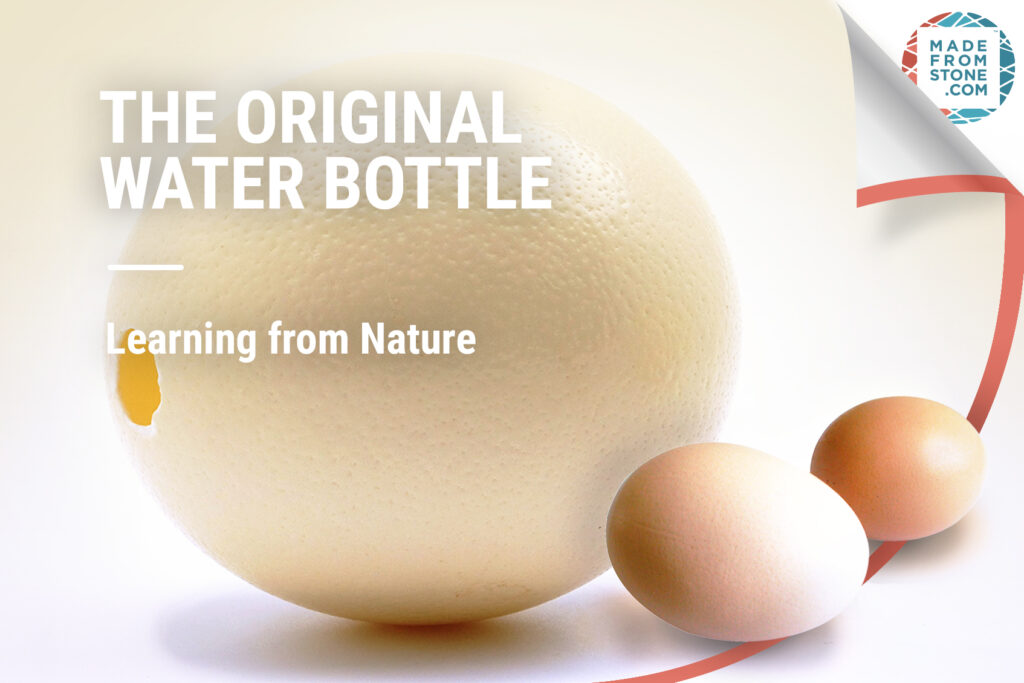
Our new series, Biomimicry, will spotlight innovations inspired by nature that have shaped the products we use every day. In this month’s edition, we’ll learn about the ostrich egg.
The first documented forms of bottles were made by converting natural items into containers. In South Africa, ostrich egg flasks dating back 100,000 years have been discovered intact. These enormous eggs were upcycled and repurposed once emptied to become natural water bottles. This was done by hammering an opening at the sharp end of the egg, draining the contents by shaking the egg, and using beeswax stoppers to prevent spillage.
Ostriches lay the largest eggs of any bird – approximately 20x the size of an average chicken egg. The eggshells are made up of 96% calcium carbonate, and 4% organic material, mostly proteins. They are typically 2mm thick and are made up of three different layers of varying strengths, allowing them to be extremely durable, protecting the baby ostrich inside and keeping it cool, making them the perfect vessel for holding water afterward. In fact, these huge eggs have an average volume of one liter – that’s a lot of liquid!
Eggs dating back 60,000 years have even been found with patterns of abstract lines, hash marks, and dots, thought to be used to indicate ownership or identify the contents. Ancient packaging with a label! Today, the San people of the Kalahari Desert in Botswana continue to use ostrich eggs to carry water, and who can blame them! Eggs are a perfect example of nature’s perfect circular packaging.
Here at Okeanos, we’re inspired by Mother Nature’s innovative packaging, and have mimicked her clever ideas in the making of Made From Stone™. After all, nature made it, we just made it into packaging.
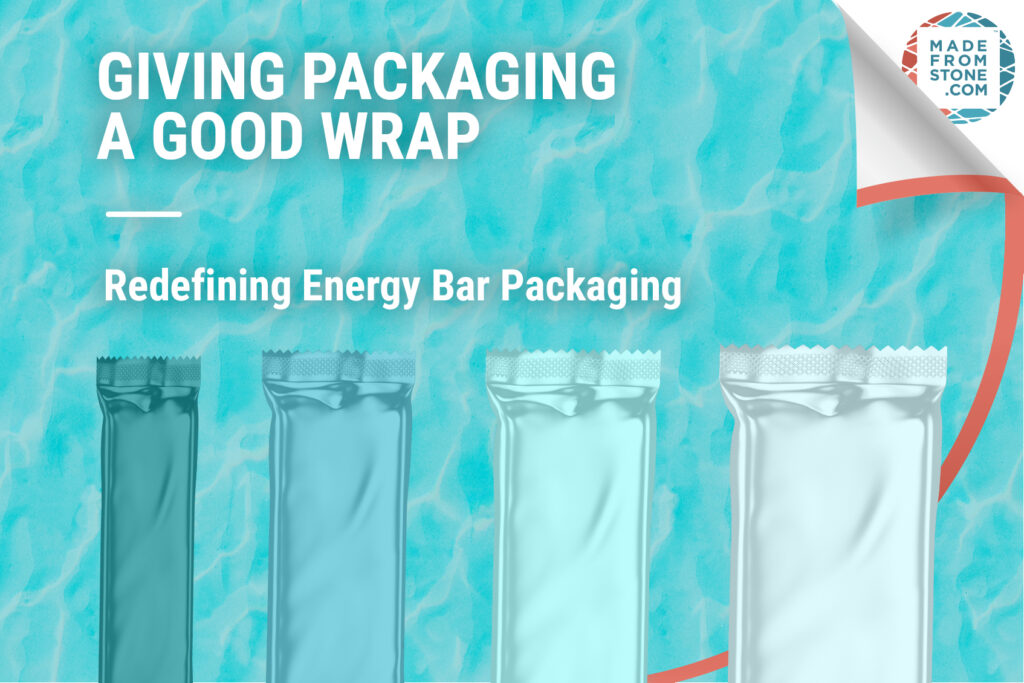
Did you know that energy bars and their metallized wrappers actually have origins in space exploration? The first bars, called Space Food Sticks, were created by Pillsbury in the 1960’s with the goal of providing an energizing snack for the astronauts that had a long shelf life, and didn’t need to be refrigerated in space. By 1970, Pillsbury had filed a trademark for Space Food Sticks and rolled them out to the everyday consumer. During this time, the single-use metallized or laminated foil wrappers they came in were not considered to be an environmental issue.
Today however, most energy bars come wrapped in a film made from two layers of flexible polypropylene plastic, with a layer of aluminum sandwiched in-between. In recent years, energy bars have gained popularity as a reliable grab-and-go healthy snack. The energy bar market has grown exponentially, with a predicted global market growth of $1.56 billion USD during 2019-2023. As the saying goes, good things come in small packages. While what’s inside these power-packed bars can be good and good for you, the packages they’re wrapped in have big consequences for the environment.
Foil lined wrapped energy bars come at the expense of sustainability, as they are not easy to recycle and they are never made with recycled content. In order to be recycled, each wrapper needs to be separated layer by layer before they can be fed into the recycling stream. This process is energy intensive and expensive from both the human and machine perspectives, which makes them much less attractive to recyclers, thereby diminishing their likelihood of being recycled. Even after separation of the layers, some material will still go to a landfill. For example, the plastic film can be recycled while the foil is discarded.
Here at Okeanos®, we are working toward changing the game when it comes to energy bar wrappers. Our Innovation Team has developed a new wrapper “system” combining Made From Stone technology with non-foil barrier materials, making it recyclable without separation of component layers. A wrapper Made From Stone will not only protect and maintain the quality of your energy bar, but have a greater potential for recycling.
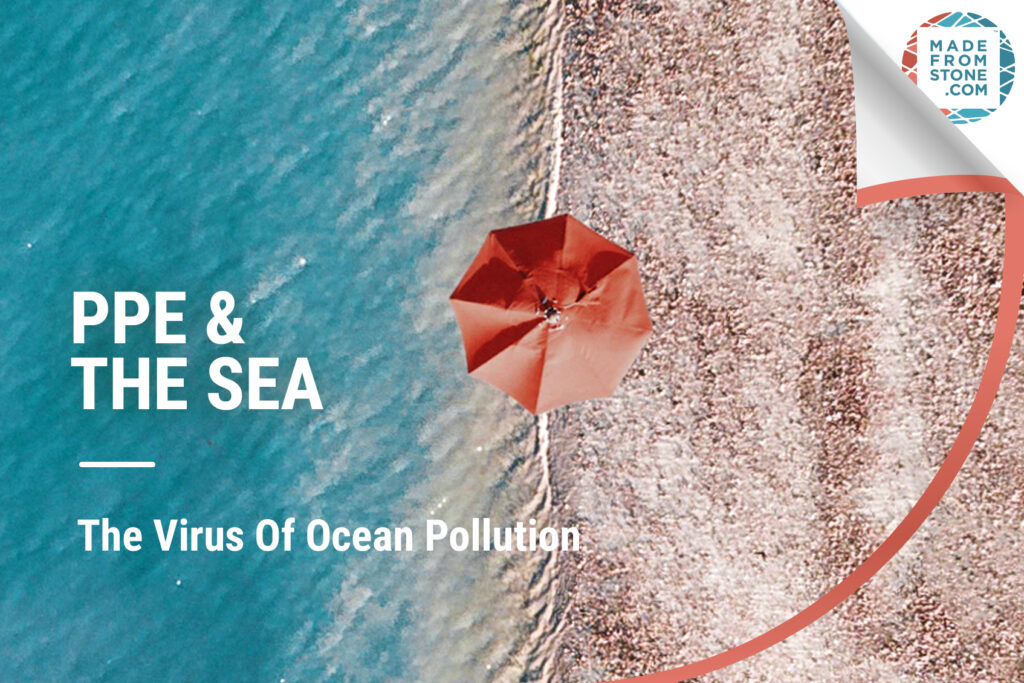
PPE or Personal Protective Equipment, has been essential in the fight to combat the spread of Coronavirus around the world. It’s been scientifically proven that the use of a face mask can prevent the virus from spreading to others, and offers a measure of protection for the wearer as well. But as we gear up to protect ourselves from the virus, are we creating yet another illness for the environment?
Oceanic organizations around the world have begun to raise the alarm about PPE making its way into our marine environments in staggering numbers. Laurent Lombard of French non-profit organization Opération Mer Propre, said his divers had already seen evidence of hundreds of discarded masks and gloves during recent dives off the French Riviera. After learning that the French government had ordered an additional two billion masks, he warned of the risk of a future with “more masks than jellyfish in the Mediterranean,” in a recent post on the organizations Facebook page.
Most single-use masks are made of polypropylene, as are gloves, goggles, and face-shields. Due to inefficient disposal methods and lack of recycling infrastructure, more and more of these items are finding their way to the ocean, where they will remain there for hundreds of years. When they break down, they will create microplastics which can be eaten by fish and plankton. Sea turtles often seek out jellyfish, one of their main food sources, and risk false satiation, or the false feeling of fullness if they mistake a passing plastic glove for a jellyfish, resulting in starvation.
According to a recent article in Bloomberg Green, sales of disposable face masks are set to rise more than 200-fold to 166 Billion this year. Fortunately, innovative companies around the world are taking notice; working toward developing more sustainable solutions including gowns and masks made from abaca, a fiber from a relative of the banana tree, and visors made from paper and wood-pulp.
Here at Okeanos, we’ve been hard at work on our own Made From Stone solution. We are currently working with a PPE manufacturer in Portugal to explore producing masks using our renewable and sustainable calcium carbonate. In the meantime, if you aren’t a frontline worker requiring medical-grade PPE, opt for a reusable, washable fabric mask instead of single-use disposables. According to the Mayo Clinic, “cloth face coverings are most likely to reduce the spread of the COVID-19 virus when they are widely used by people in public settings.”
If you’re looking for more information about our sustainable packaging technology contact us at trade@madefromstone.com .
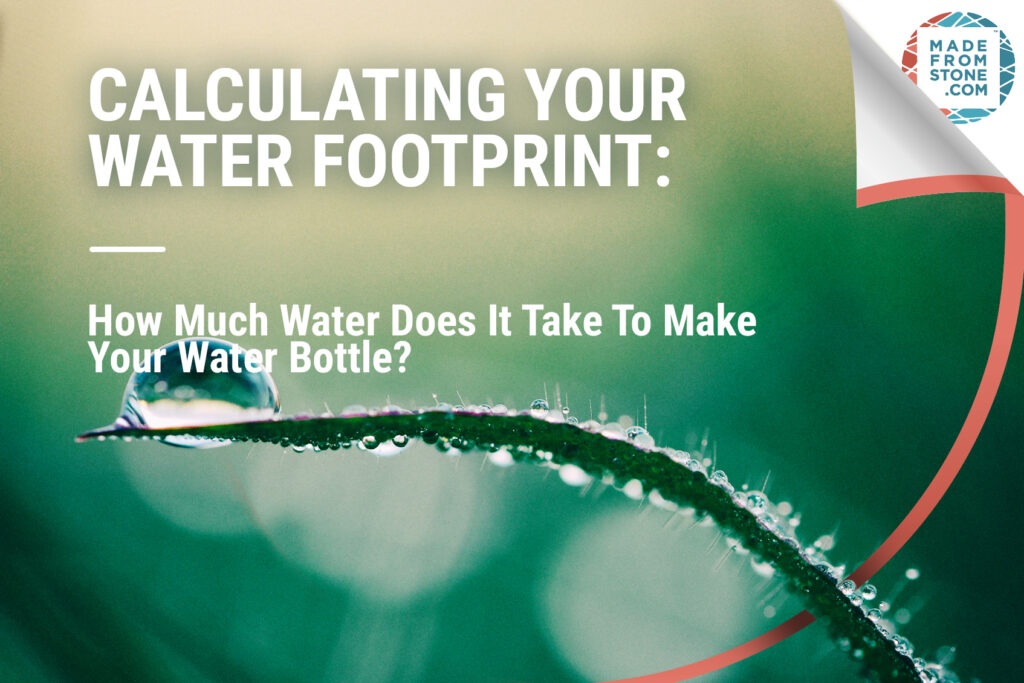
In last month’s issue, we focused on eutrophication potential. Factors that determine how we measure sustainability at large. This month, we’re diving into water usage in packaging production with Dr. Russell Petrie.
Q: We are all familiar with our carbon footprint, but is there such thing as a water footprint?
A: Yes. A water footprint is defined by calculating the total amount of freshwater used to produce goods and services accounting for the amount of water that’s been contaminated during a product’s production. Using this calculation, it’s possible to determine the water footprint of an individual, business, city or even a country. However, it is often difficult to get an accurate comparison between compounds and products.
Q: Why is it important to be aware of our water footprint?
A: Keeping track of our water footprint allows us to be more efficient and sustainable with our water use, which is especially important in areas where freshwater is scarce.
Q: Ok, so what are the components we need to consider when calculating water footprint?
A: There are three considerations, organized by color: Green Water, Blue Water, and Gray Water.
Q: Green Water and Blue Water seem self-explanatory, but why is Gray Water important?
A: Gray Water calculations help us to measure the pressure we put on water resources as a result of pollution. For example, a recent report indicated that four out of five freshwater sources in China are unsafe for drinking due to industrial pollutants.
Q: So how do the different types of packaging stack up in Gray Water footprint?
A: Plastics account for the largest annual grey water footprint of packaging, followed by paper, glass, steel, and aluminum. According to the Water Footprint Network, the grey water footprint caused in the production of plastic packaging could supply China’s households with water for six months.
Q: So where and how the product is made play a factor in the water footprint?
A: Yes. Water footprints take into consideration all of the water consumed on the entire production of the product from its inception until it winds up in your hand. In areas of the world where freshwater is scarce, a product requiring a lot of water to produce will have a significant impact. For example, in order to make an aluminum can, water is polluted in countries like Australia and Brazil where bauxite (the raw material needed to make aluminum) is mined. More water is then polluted when the can is manufactured in countries like China, the main world producer of aluminum products.
Q: So what is the water footprint of a plastic bottle of water?
A: According to a 2011 study by the Water Footprint Network, the estimated Blue Water footprint of converting “oil to PET” was 2.64 gallons of water per pound. With the addition of the Gray Water footprint, the overall water footprint rose to 28 gallons per pound. Based on these numbers, it takes about 1.4 gallons of water to produce a typical single-use water bottle!
Q: Why would using CaCO3 (calcium carbonate) be a good idea from a water footprint standpoint?
A: CaCO3 has the lowest water footprint of any packaging material. As such, Made From Stone products have the potential to reduce the water footprint of packaging by 50% compared to similar products made out of pure plastic. Compared to other packaging materials such as paper, biopolymers, aluminum, the reduction is significant as well.
Try using this helpful Water Calculator to calculate your personal water footprint. https://www.watercalculator.org/
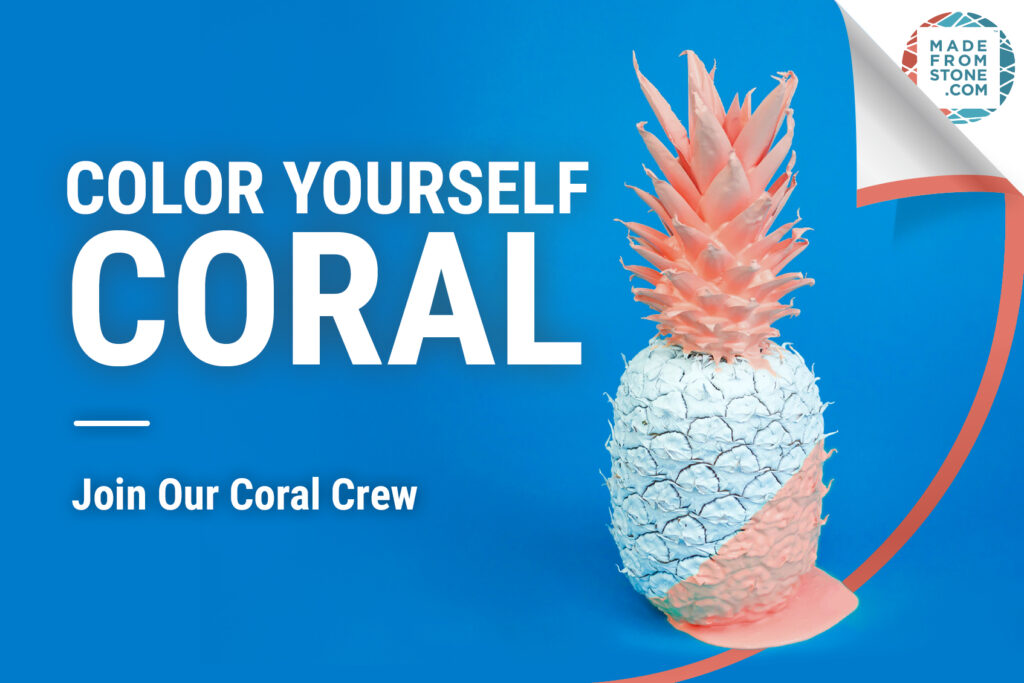
Introducing the Coral Crew, our sustainability street team!
Who are they?
The Coral Crew are a diverse group of passionate and active doers. They are committed to sharing the Okeanos mission and educating others on our brand while participating in foundation projects to make visible change in our world. Our Coral Crew is fit for many, we are looking for people with all types of unique skills. Whether a scholar, artist, diver, scientist, musician, teacher, each hold the ability to drive change through their talents. Not all may be experts, but they are devoted activists – eco-warriors on a quest to make a difference we can see.
Social media can help spark important conversations within our communities. By harnessing the power of digital conversations, the Coral Crew can further the goal of leaving the earth better than we found it. Even a single post has the potential to inspire thousands. From awareness to education, we can challenge our audiences to stop scrolling past our planet’s needs, and start learning about solutions that work.
Members of the Coral Crew will:
Want to become a Coral Crew member? DM us on Instagram or Facebook.
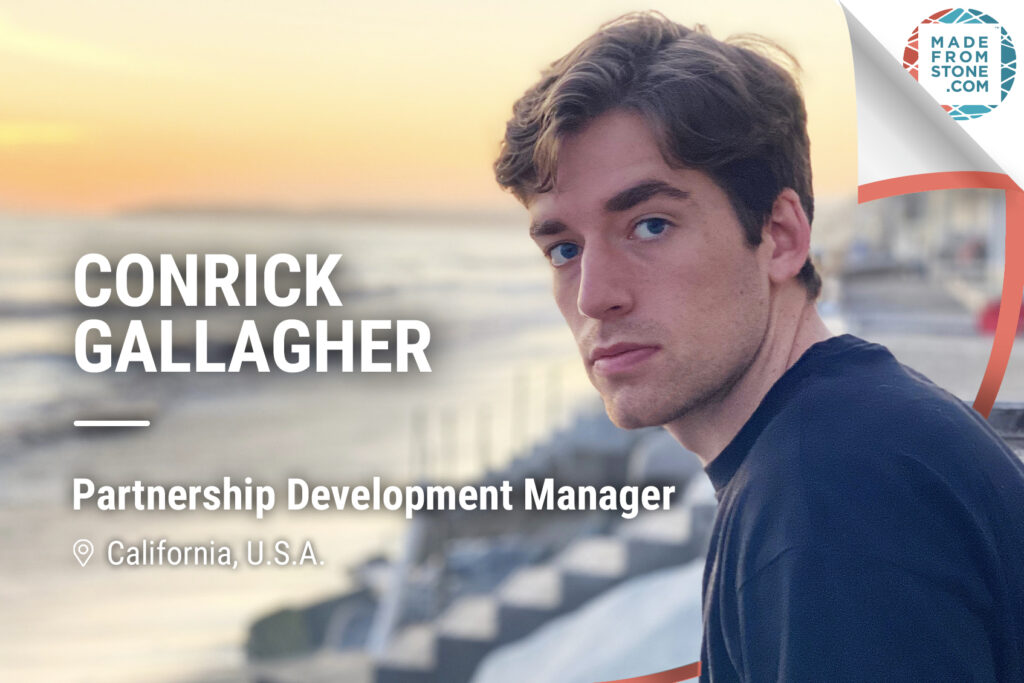
August’s Rockstar is someone that we are proud of having as a colleague. Please meet Conrick Gallagher! He’s lived and traveled the globe bringing a wholesome perspective to each person he meets. With his passion, professionalism, and strong work ethic, Conrick is driving growth by building, maintaining and managing our global partner channel.
Q: Conrick, tell us a little about your life before Okeanos.
A: I spent my first semester of college living and learning on Semester at Sea, a university program based on a large ship. Traveling to 11 different countries, I learned valuable lessons about interpersonal and inter-country relations. At the University of Miami, I pursued a career in Sports Business. I had a fantastic four years studying and working in sports, yet I realized I wasn’t satisfied. As far back as I can remember, I’ve always been interested in finding ways to protect the environment. I expressed my interests in sustainability to the Dean at UM, and to my surprise, he offered me the opportunity to be a member of the inaugural class of the new Masters in Sustainable Business program. I dove right in! I am truly grateful for that five-minute conversation, because it helped put me on a path toward making meaningful change in the environment, and led me directly to Okeanos too!
Q: What countries have you lived in? Have you noticed a large difference in pollution initiatives in these different countries?
A: I am extremely fortunate for the time I spent living outside of the United States during middle and high school. My family lived in Sao Paulo, Rome, and London over a six-year period. We also had the opportunity to travel extensively. This experience opened my eyes to the ways in which citizens of other countries live. We have become so accustomed to being a ‘throwaway society’. Pollution is everywhere – especially in coastal environments. Some of the countries in Northern Europe do a better job in tackling this problem, but generally we all need to do more.
Q: What motivates you each day with the work you do?
A: I have always wanted a career that allowed me to impact the lives of others. Fresh off a Master’s degree in Sustainable Business, I could not ask for a better opportunity than the one I’ve been given at Okeanos. I walk into work every single day knowing that what I am doing has a greater purpose. We all have a responsibility and the ability to leave Earth better than the way we found it. Okeanos is giving me the opportunity to do so every day.
Q: How does having a global perspective help with your role working with the joint ventures?
A: Understanding cultural norms and differences is important in any business that operates globally. Living abroad and attending international schools provided me with a unique perspective and the knowledge that there are multiple ways of solving a problem. From Brazil to Bangladesh and from Spain to Saudi Arabia, I speak to people all around the globe on a daily basis. In these conversations, it’s essential that we have an understanding of the other person’s perspective and their country’s societal norms. I love this challenge, and I look forward to continuing to learn and grow with the company.
Q: What excites you the most about being a Coral Crew member and what are your main goals?
A: My role as the Partnership Development Manager allows me to create and maintain relationships with companies around the world. The Coral Crew offers something a bit different. As a member, I am able to mobilize my network, and be an ambassador for change on behalf of Okeanos and the environment. The Coral Crew gives me the opportunity to educate my “crew” about the fact that it’s easier than they probably think to make sustainable choices. Having a platform to express my opinion and educate others on sustainable practices is very important to me. If I can make a difference in at least one person’s life, I get a little closer to my goal of making the environment around us a cleaner, safer, and healthier place to leave behind.
Q: What is your favorite ocean activity?
A: Through all the travel in my life the one place that has remained a constant for me was my home in San Clemente, California. I grew up 15 steps from one of my favorite things in the world, the ocean. Naturally this allowed me to take up a few ocean activities including body surfing, swimming, diving and paddle boarding, with the occasional surf session thrown in. Oh, and fun fact: I got my Padi Diving license in Zanzibar, Tanzania.
Q: Based on what you’ve learned here at Okeanos, what is your advice to those looking to lead more sustainable lives?
A: Before discovering Okeanos, it didn’t even occur to me that calcium carbonate could be the solution in our fight against plastic pollution. As someone who studied sustainability in school, I’ve learned that there are a lot of alternatives out there. The majority of these alternatives are either too expensive or sacrifice performance. Made From Stone technology defies sustainable product stereotypes. Okeanos has been innovative in finding ways to reduce plastic at the source, in a way that takes the burden off of the consumer. Okeanos has taught me that creativity and stepping outside of our comfort zone plays a big part in leading a sustainable life. So, for those of you reading, I challenge you to be creative. Start with one choice a day to benefit the environment around you.
Q: What quote or words do you live by?
A: “Knowing where you came from is no less important than knowing where you are going.” This quote by Neil deGrasse Tyson comes from his book, Astrophysics for People in a Hurry. This can of course, be interpreted in many ways, but to me it is simple. You cannot control or change the past but can change the trajectory of your future. So yes, your past is important, it’s what made you who you are today, but what’s more significant is what you will make tomorrow.
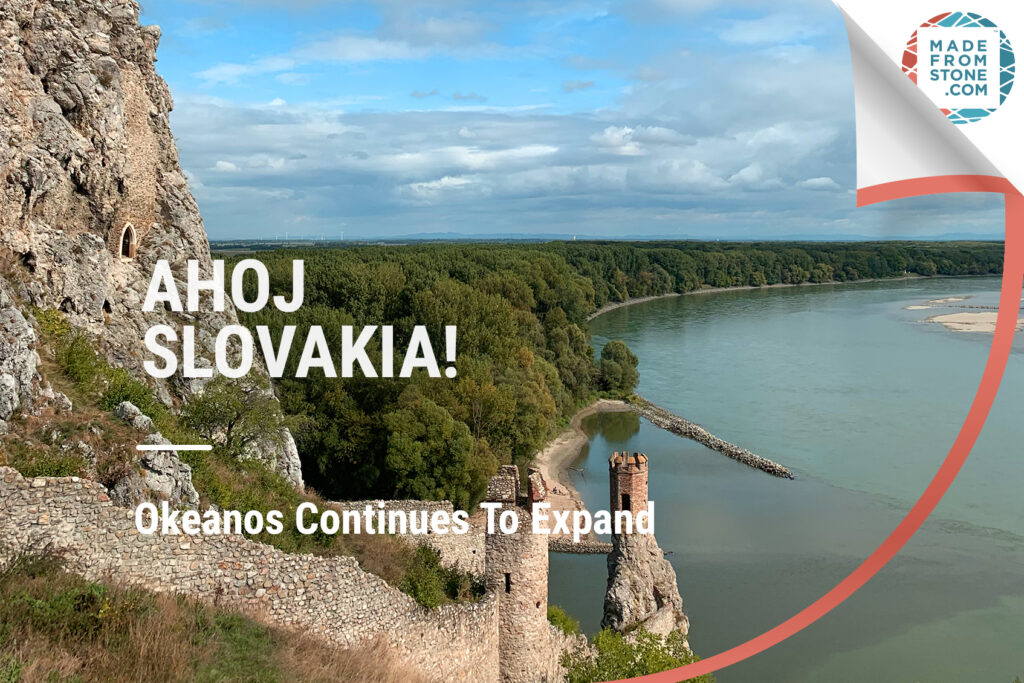
This September, we’re excited to announce the opening of a new Okeanos sales office in Bratislava, Slovakia. Okeanos CEE will be helmed by entrepreneurs Marco Vicel, Jacob Matysak, and Daniel Levarsky. In an interview with Marco, who has been closely tracking the progress of Okeanos since it began, he explains,
“Europe is constantly evolving and is becoming more and more eco-friendly. This is not only visible in legal framework, but also in consumer demands. Therefore, we believe that Okeanos’ technology is the right solution for the European market and beyond. The technology is very unique and differentiated from all other substitutes, not only in terms of solution’s parameters, but also due to cost benefits for manufacturers.”
In 2019, Slovakia joined the other countries in the European Union in their commitment to banning single-use plastic by 2021, increasing the national appetite for an ecological alternative. “Based on public data,” Marco explains “there are 2.4 million ton of plastics pollution in the Mediterranean Sea. We know this is the right time to launch Okeanos in Central and Eastern Europe. Abundant resources of calcium carbonate together with economic viability, consumption safety, and flexibility are the key differentiators and attributes that manufacturers are looking for to substitute single-use plastics and to conform with the EU legislation. Okeanos can deliver the exact solution for these needs, and we’re excited to be part of the team.”
The Okeanos team is continuously growing with opportunities around the world. For the most up to date job openings visit our LinkedIn here.

| Cookie | Duration | Description |
|---|---|---|
| cookielawinfo-checkbox-analytics | 11 months | This cookie is set by GDPR Cookie Consent plugin. The cookie is used to store the user consent for the cookies in the category "Analytics". |
| cookielawinfo-checkbox-functional | 11 months | The cookie is set by GDPR cookie consent to record the user consent for the cookies in the category "Functional". |
| cookielawinfo-checkbox-necessary | 11 months | This cookie is set by GDPR Cookie Consent plugin. The cookies is used to store the user consent for the cookies in the category "Necessary". |
| cookielawinfo-checkbox-others | 11 months | This cookie is set by GDPR Cookie Consent plugin. The cookie is used to store the user consent for the cookies in the category "Other. |
| cookielawinfo-checkbox-performance | 11 months | This cookie is set by GDPR Cookie Consent plugin. The cookie is used to store the user consent for the cookies in the category "Performance". |
| viewed_cookie_policy | 11 months | The cookie is set by the GDPR Cookie Consent plugin and is used to store whether or not user has consented to the use of cookies. It does not store any personal data. |
